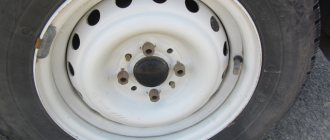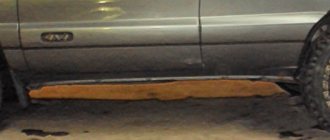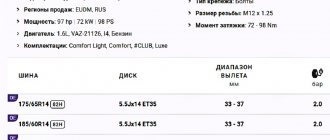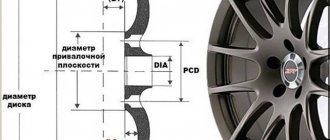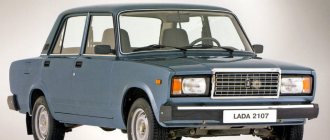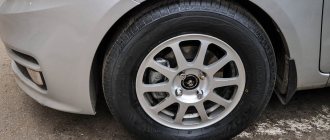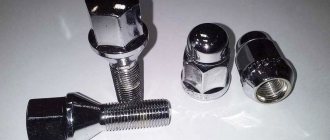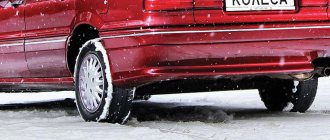When planning to purchase a new set of wheels for your car, you should never forget about the importance of wheel bolt patterns. A bolt pattern is a combination of various measured characteristics that allow you to select the appropriate set that fully matches the characteristics of a particular vehicle. To take measurements, you can use tools and do the work yourself. An alternative is special compatibility tables. Car owners who have only recently started operating their cars on their own do not fully understand the complexity of choosing wheels for their vehicle. The kits can differ significantly from each other and be intended for completely different cars, although externally it is extremely difficult to find the difference between them.
Method for determining the bolt pattern of wheel rims.
Size indicators
When purchasing a car, especially the first one, the owner rarely thinks about the fact that he should choose wheels carefully. Kits on the market often differ because they are designed for different cars, although there may not be any visible differences.
In order for the selection to be accurate and the wheels to fit the car, a number of sizes are taken into account. If there is an error in determining one of them, the disks will not be installed, but even if successful, operation of the machine will become unsafe. Before measuring the bolt pattern, you should understand what is included in it. Among the main sizes:
- number of holes for mounting the wheel (in the marking it is designated as LZ);
- distance between screw holes;
- the diameter of the circle along the edges of which holes for the bolts are made (in the disk marking it is designated as PCD);
- hub window indicator (you can find it out by the DIA number);
- degree of disc overhang (the ET marking is responsible for it).
Each of the characteristics is important when choosing a disk set. Their accounting becomes mandatory if wheels are purchased remotely - if they are incompatible, you will need to spend time communicating with the seller, returning the goods, or searching for a new set.
Passenger cars typically use 3-6 bolts per disc, which is much less than trucks. Given the diameter and weight of their wheels, each requires 12-15 bolts to secure.
Important! Domestic cars, especially Soviet-made ones, mostly have 4 bolts for installing disks. The Niva is an exception; its wheels use 5 bolts.
You can determine the exact number of fasteners needed to mount the wheels by looking at the stock wheels. By simple inspection it will become clear how many sockets are in the wheel and how many bolts are needed for them.
What types of discs are there?
Car wheels are produced in accordance with technological features, so new options are constantly appearing to allow customers to choose exactly the option that fully satisfies their requirements and preferences.
The table describes the main types of disks and their characteristic features.
| Type | Description |
| Cast | Light weight and strength are the main technical parameters that ensure comfort when driving a car with such discs. But in the absence of proper maintenance, the protective layer quickly wears off, which is why the product may become rusty. |
| Stamped | Affordable cost with the ability to “straighten” the disc if necessary is the key to convenient maintenance. As a rule, this type of disc is included in the factory kit of many cars. |
| Forged | Increased strength is justified by a special manufacturing technology. Also, when driving, the discs do not burst, as is the case with cast ones. But the high cost makes such wheels not available to every car owner. |
| Prefabricated | This is an experimental version of discs that appeared on the market relatively recently, but has already become very popular due to its unusual appearance. |
Regardless of the type of wheel you choose to equip your car with, it is important to know how to correctly determine the bolt pattern so that you don’t encounter technical difficulties when installing and using the wheel in the future. Experts have identified several methods to choose from, but it’s worth familiarizing yourself with each individually.
How to measure yourself
It’s possible to find out the bolt pattern yourself; this is possible with a ruler (preferably a caliper). They measure the distance between the windows, and the ruler has an error because it does not take into account the bend. You can take measurements in several ways, which are combined for greater accuracy.
Adjacent holes
This parameter is determined taking into account the indicator of the circle where the central part of the slot made for the mounting bolts is located. The diameter can be easily calculated using a ruler, although a compatibility table has been developed for popular cars. If a ruler is used, then the distance between adjacent bolts is measured in a straight line.
The resulting figure is multiplied by a coefficient determined by the number of holes in the disk. It should be said right away that the transverse circumference of VAZ cars is standardized at 98 mm, and in Niva it is 139.7 mm. The coefficients are as follows:
- 3 bolts – 1.155;
- 4 fasteners – the value for multiplication is 1.414;
- 5 – 1,701;
- 6 bolts – 2;
- 10 pins – 3.326.
Far windows
Instead of nearby holes, you can determine the bolt pattern even with a ruler with minimal error, using distant windows. The easiest way to measure wheels is if there is an even number of bolts - 4,6,8. The length of a straight line drawn between opposite holes will indicate the required value.
If there are 5 bolts on the disk, the distance between holes that are not adjacent is measured. The resulting figure is multiplied by a coefficient of 1.051, which gives the most accurate PCD result.
Hub window diameter
The hub center window size is specified in the bolt pattern charts and the complete bolt pattern formula mentioned below. Even if there is no ready-made information at hand, the results can be easily obtained with a ruler or a more accurate caliper. For example, the window diameter in the VAZ model 2110 is made at 58.6 mm.
Interesting!
It is not always possible to measure this indicator due to the irregular shape; Daewoo Nexia has such in its pre-restyling body.
In addition to the listed characteristics, disc offset is also important. It refers to the location of the vertical axes of symmetry of the wheel in relation to the point of alignment with the hub. The offset can be negative, as well as zero or positive, but even if the selection for it was unsuccessful, the disk can be installed. This is undesirable, because the car’s suspension will begin to function incorrectly and will greatly impair driving safety.
Bolt pattern formulas
To accurately determine whether the kit and car make are compatible, bolt pattern formulas are used that indicate the parameters of the disks. There are abbreviated and full values, but absolutely all parameters are indicated only in the latter.
Full
This formula is used by disc manufacturers who apply the appropriate markings to their products. It looks like: 8Jx15 H2 4x100 ET0 D54.1 and for an inexperienced car owner it is a random set of numbers and letters. In fact, each parameter can be deciphered:
- 8 Jx15 – the first number indicates the width of the rim, the diameter being 15 inches. The X here represents the type of wheel, in this case they are cast or forged. The letter J indicates the possibility of using the wheel only on cars with single-wheel drive - rear or front, because all-wheel drive is designated as JJ.
- H2 – displays the number of haps, which are otherwise called horse lugs. They hold tubeless tires on the rim and there are products with one hub or without it at all. These elements secure the tire, preventing it from depressurizing, and also help to corner more efficiently.
- 4x100 is a PCD indicator, the first digit in which reflects the number of bolt sockets, the second - the transverse diameter of the circle.
- ET0 – gives an understanding of the disc offset, in this case it is zero. If the number is 40, this is a positive offset, and the designation ET-40 shows a negative offset.
- D54.1 - this designation indicates the diameter of the hub window, the figure is given in millimeters.
The diameter and width of the wheel rim are indicated in inches, while other characteristics are reflected in millimeters.
Abbreviated
The abbreviated digital characteristic is simplified; it contains only two indicators. the 4x98 formula reflects that the wheel has 4 bolts located along a 100 mm circumference. This is the standard bolt pattern of the VAZ 2110; other cars also have circles from 100 to 139.7.
Before purchasing wheels, measure the hub. There may be no differences, for example, a disk with a 98-th circle will visually fit on a hub with a diameter of 100. In practice, such a disk will not fit tightly to the hub, the wheel will be skewed, and safety will be at risk.
Departure parameter
In the example under consideration, the “offset” indicator is 30. This means that the gap between the center of the width of the wheel rim and the so-called mating plane is 30 millimeters. The last parameter is the plane with which the wheel disk is pressed directly to the hub. Note that the product will have zero “overhang” if they are absolutely identical. The “offset” can be considered positive if there are no points of intersection of the two mentioned planes. If the transfer plane goes beyond it will be negative.
German concerns that produce wheels designate the “offset” parameter with the symbols ET. In the example we are considering, this indicator is positive (YE30). A negative offset will be indicated as ET-30 (with a hyphen). French manufacturers designate this parameter as DEPORT. In other countries, as a rule, the designation OFFSET is used.
The “offset” indicator is no less important than the bolt pattern. It must be taken into account when installing wheels. If “offset” has a negative value, this may cause the element to protrude outward. In this case, when turning, it will rest against the wheel arch. Positive “overhang” implies a preferential location of the disk inside. If you do not take into account the correspondence of the “offset”, it will simply be impossible to carry out installation. This is due to the fact that the suspension elements will prevent this.
Bolt tables
Calculating the bolt pattern is rarely used, because there are compatibility tables. The driver needs to find a table for a specific model and look at the parameters for it. They include all popular cars used in Russia.
| Bolt pattern | Cars |
| 4*98 | VAZ; Fiat Panda, Lineo, Qubo; Ford Ka; Lancia Delta; Peugeot Bipper. |
| 4*100 | BMW Z1; Chery; Chevrolet Aveo; Daewoo Lanos; Dacia Logan; Fiat Punto; Hyundai Accent, Getz, Solaris; Honda Accord; VAZ Largus. |
| 4*108 | Audi 80; Citroen Berlingo; Ford Fiesta, Mondeo; Mazda 2. |
| 5*100 | Audi A1 (2.3), TT; Chrysler Neon, Sebring, PT Cruiser; Honda Civic; Nissan Sunny, Sunfire; Seat; Skoda Fabia Subaru Forester, Impreza, Legacy, Outback; Toyota Avensis and Camry; Volkswagen Golf, Bora, Beetle, Polo; GAS Siber. |
| 5*108 | Aston Martin Vanquish; Citroen C5, C6; Ford Focus, C-Max; Renault Clio, Kangoo; Land Rover. |
| 5*112 | Audi A3, A5, A6, RS4, RS5; Bentley; BMW; Mercedes-Benz; Ssang Yong Actyon, Chairman; Volkswagen Jetta, Transporter. |
This table does not contain all the bolt patterns, because there are many more cars. You need to look for the bolt pattern yourself for a specific car, this will help you accurately select the wheels.
Additionally! If the discs are still selected incorrectly, they can be processed by widening the hub window and changing the locations of the holes for the bolts. This is very difficult to do; in most cases, attempts end not only in disk damage, but also in accidents.
The disc bolt pattern is extremely important, because if it is selected incorrectly, the suspension will not work as it should and the car may get into an accident. To make an accurate choice, they focus on several indicators, including the diameter of the hub, the number of holes, and the size of the circle. There are also bolt patterns that will allow you to quickly select a set of wheels compatible with your car.


